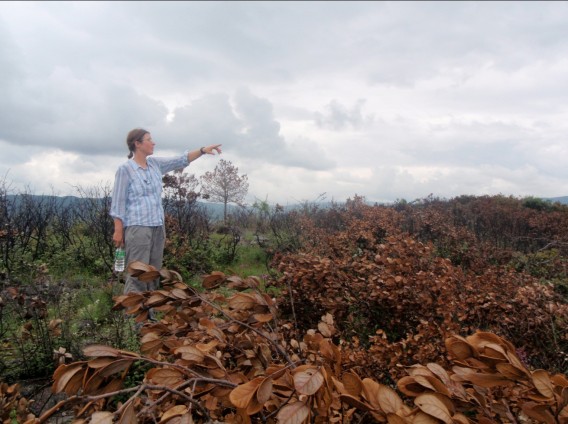by: Meg Krawchuk

Fire and climate change is a really hot topic — pardon the pun — when it comes to climate science. Why? We know quite a bit about the tight relationship between fire and climate and that future climate change will alter the geographic distribution and abundance of vegetation fire. Where, how, and when this occurs are very much open questions.
Fires are complicated. First, they release greenhouse gases, but keep in mind that if vegetation regrows, that carbon is recaptured and stored. Second, fires disturb ecosystems, but the ecological effect depends very much on whether an ecosystem is fire dependent or fire sensitive. Third, even in fire-dependent ecosystems, flames can hurt people and damage property. So thinking about fire and climate is a must for conservation scientists like myself.
The recent work The Nature Conservancy has been doing on climate change and fire in China uses statistical models to predict various possibilities of changing fire activity related to climate change. I looked closely at a handful of landscapes — 32 areas designated as priorities for conservation by The Nature Conservancy China Program.
Under one climate-change scenario, 27 of the 32 areas showed that they were vulnerable to changes in fire due to a global warming. But note the wording here: I’m saying “changes.” The research showed that there would be increases in some regions but decreases in others. Though climate change means global warming, an increasing average global temperature is not necessarily leading to more fire across the board. Projections show that there could be more fires in areas of central and northern China, but fewer fires for southern and eastern areas. This may be surprising, but remember that climate change means altered temperature and precipitation. More rains can douse fires, and less rain can result in more stress on trees and the land, and also less vegetation available to burn. The fire-climate story is more complex than a simplified relationship of higher temperatures equaling more fire.
The findings highlight a need for clear identification of conservation goals. Do you want to conserve the ecosystem we see today? Or do you want to try to let the ecosystem adapt and evolve to the changes in climate. The latter seems kind of exciting to me, the ultimate climate experiment! But this may result in the loss of species or even human communities.
In China, conservation management considering future climate in Yunnan’s South Hengduan Mountainous Area might mean the loss of habitat for the Yunnan Golden Monkey. And what is the role of people? Land use and cultural history in China is vastly different from what we’ve experienced in North America. How do we think about conservation in this context? These are complicated questions to be decided upon through dialogue among local communities, conservation scientists, and government representatives.
This past September, I headed into the field to see what my findings looked like in real life. I call this “going to smell the numbers.” The destination was northern Yunnan, one of the most biodiverse areas of China, and also reputed as one of the most remote. I was amazed at the extent of road building in the north along the wondrous Mekong River as we emerged over the hillside after hiking overland from the Nu River (Nujiang), and at the new road being built into the previously secluded town of Dimaluo to support a dam on the river that feeds into the Nu.
This raised difficult questions for me. What is the role of conservation? Where should it trump development that provides basic services to communities, and where should it not? How do we attain sustainable development and what is the role of developing countries? The latter discussion is key to figuring out what the world does about climate change. Meanwhile, we have to remember that climate change isn’t the only conservation threat in the room.
Meg Krawchuk is a postdoctoral research fellow at the University of California at Berkeley. Her work with The Nature Conservancy’s China Program focuses on climate-induced changes in fire activity in China.
Photo courtesy of Meg Krawchuk (The author in northern Yunnan, one of the most biodiverse areas of China.)
Read it at the Source
